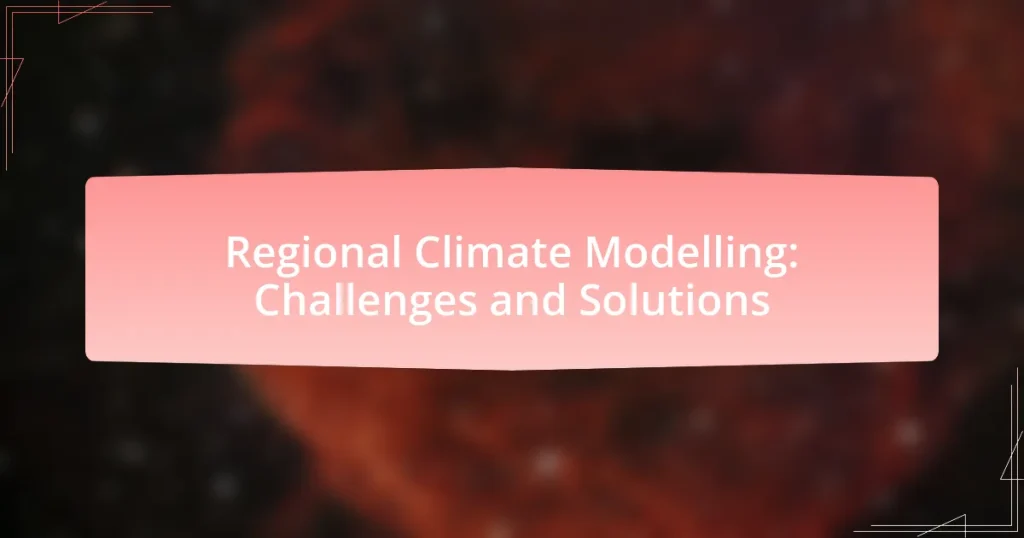Regional Climate Modelling is a scientific method that simulates and predicts climate patterns within specific geographic areas, utilizing high-resolution models to capture local dynamics often missed by global models. This article explores the differences between regional and global climate modelling, highlighting the importance of spatial resolution and local climate processes in enhancing predictive accuracy. It addresses the primary objectives of regional models, their role in climate change adaptation and policy-making, and the challenges they face, including computational demands and data limitations. Additionally, the article discusses solutions to these challenges, such as advancements in technology, collaborative approaches, and best practices for ensuring model reliability.

What is Regional Climate Modelling?
Regional Climate Modelling is a scientific approach that focuses on simulating and predicting climate patterns and changes within specific geographic regions. This method utilizes high-resolution climate models to capture local climate dynamics, which are often overlooked in global models. Regional Climate Modelling is essential for understanding localized climate impacts, such as extreme weather events, and for informing regional policy and adaptation strategies. The accuracy of these models is supported by their ability to incorporate detailed topographical and land-use data, which enhances their predictive capabilities for specific areas.
How does Regional Climate Modelling differ from Global Climate Modelling?
Regional Climate Modelling focuses on specific areas or regions, while Global Climate Modelling encompasses the entire planet. Regional models provide higher resolution and detail, allowing for localized climate predictions, which is crucial for understanding impacts on ecosystems and human activities. In contrast, global models operate at a coarser resolution, capturing broader climate patterns and trends but lacking the granularity needed for regional assessments. This distinction is essential for effective climate adaptation strategies, as evidenced by studies showing that regional models can better predict extreme weather events and their local impacts compared to global models.
What are the key features of Regional Climate Modelling?
The key features of Regional Climate Modelling include high spatial resolution, incorporation of local climate processes, and the ability to simulate climate variability and change at a regional scale. High spatial resolution allows for detailed representation of topography and land use, which significantly influences local climate patterns. Incorporating local climate processes, such as land-atmosphere interactions and hydrological cycles, enhances the model’s accuracy in predicting regional climate phenomena. Additionally, these models can capture climate variability and extremes, providing valuable insights for climate adaptation and mitigation strategies.
Why is spatial resolution important in Regional Climate Modelling?
Spatial resolution is crucial in Regional Climate Modelling because it determines the level of detail and accuracy in simulating climate processes and phenomena. Higher spatial resolution allows for better representation of local topography, land use, and climate interactions, which are essential for understanding regional climate variability and extremes. Studies have shown that models with finer spatial resolution can capture localized weather events, such as heavy rainfall or heatwaves, more effectively than coarser models, leading to improved predictions and risk assessments for specific areas. For instance, research published in the Journal of Climate indicates that increasing spatial resolution from 50 km to 10 km significantly enhances the model’s ability to simulate precipitation patterns in mountainous regions, demonstrating the importance of spatial resolution in achieving reliable climate forecasts.
What are the primary objectives of Regional Climate Modelling?
The primary objectives of Regional Climate Modelling are to provide high-resolution climate projections, assess regional climate impacts, and support local adaptation strategies. These models aim to capture the specific climatic features and variability of a region, which global models may overlook. For instance, regional climate models can simulate localized phenomena such as mountain effects on precipitation or coastal influences on temperature, thereby offering more accurate data for decision-making. This localized approach is essential for understanding the potential impacts of climate change on ecosystems, agriculture, and urban planning, enabling stakeholders to develop targeted responses.
How does Regional Climate Modelling contribute to climate change adaptation?
Regional Climate Modelling contributes to climate change adaptation by providing localized climate projections that inform decision-making for vulnerable communities. These models simulate climate variables such as temperature, precipitation, and extreme weather events at a regional scale, allowing stakeholders to assess potential impacts on agriculture, water resources, and infrastructure. For instance, a study by the Intergovernmental Panel on Climate Change (IPCC) highlights that regional models can improve the accuracy of climate forecasts, enabling better planning and resource management in response to climate risks. This localized data is crucial for developing targeted adaptation strategies that enhance resilience against climate change effects.
What role does Regional Climate Modelling play in policy-making?
Regional Climate Modelling plays a critical role in policy-making by providing localized climate projections that inform decision-makers about potential impacts of climate change. These models simulate climate conditions at a regional scale, allowing policymakers to assess risks related to extreme weather events, water resources, and agricultural productivity. For instance, the Intergovernmental Panel on Climate Change (IPCC) emphasizes that regional models enhance the understanding of climate variability and change, which is essential for developing effective adaptation and mitigation strategies. By integrating scientific data into policy frameworks, Regional Climate Modelling supports evidence-based decisions that aim to reduce vulnerability and enhance resilience in communities.

What are the main challenges in Regional Climate Modelling?
The main challenges in Regional Climate Modelling include high computational demands, limited data availability, and the complexity of regional climate processes. High computational demands arise from the need for fine spatial resolution to capture local climate phenomena accurately, which requires significant processing power and time. Limited data availability affects model calibration and validation, as many regions lack comprehensive observational datasets. Additionally, the complexity of regional climate processes, such as interactions between land, atmosphere, and ocean, complicates model development and increases uncertainty in projections. These challenges hinder the effectiveness of regional climate models in providing reliable climate predictions.
What technical limitations affect Regional Climate Modelling?
Technical limitations affecting Regional Climate Modelling include insufficient spatial resolution, inadequate representation of physical processes, and limited computational resources. Insufficient spatial resolution can lead to inaccuracies in simulating local climate phenomena, as many models operate at a coarser scale than necessary for detailed regional analysis. Inadequate representation of physical processes, such as cloud formation and land-atmosphere interactions, can result in significant errors in climate predictions. Limited computational resources restrict the ability to run high-resolution models or ensemble simulations, which are essential for capturing the complexity of regional climates. These limitations have been documented in studies, such as the IPCC’s Sixth Assessment Report, which highlights the challenges in accurately modeling regional climate systems due to these technical constraints.
How do computational resources impact the accuracy of models?
Computational resources significantly impact the accuracy of models by determining the complexity and resolution at which simulations can be run. Higher computational power allows for more detailed models that can incorporate a greater number of variables and finer spatial and temporal resolutions, leading to improved predictive accuracy. For instance, studies have shown that models with higher resolution can capture local climate phenomena more effectively, as evidenced by the work of Giorgi and Mearns (2002) in “Calculation of average, maximum and minimum climate change in the region of the United States” published in the Journal of Climate, which demonstrated that increased computational resources led to more accurate regional climate projections. Thus, the availability and allocation of computational resources directly correlate with the fidelity of climate models.
What are the challenges related to data availability and quality?
The challenges related to data availability and quality in regional climate modeling include insufficient data coverage, inconsistencies in data sources, and limitations in temporal and spatial resolution. Insufficient data coverage arises when certain regions lack adequate observational data, which hinders accurate modeling. Inconsistencies in data sources occur due to variations in measurement techniques and standards, leading to discrepancies in datasets. Limitations in temporal and spatial resolution restrict the ability to capture fine-scale climate phenomena, affecting the reliability of climate projections. These challenges can significantly impact the effectiveness of regional climate models, as highlighted by studies indicating that high-quality, comprehensive datasets are crucial for improving model accuracy and reliability.
What are the uncertainties associated with Regional Climate Modelling?
Uncertainties associated with Regional Climate Modelling primarily stem from limitations in model resolution, parameterization, and boundary conditions. Model resolution affects the ability to accurately represent local climate processes, leading to potential inaccuracies in predictions. Parameterization involves simplifying complex physical processes, which can introduce errors, particularly in areas like precipitation and cloud formation. Boundary conditions, including initial and lateral conditions, can also vary, impacting the reliability of model outputs. Studies have shown that these uncertainties can lead to significant variations in climate projections, emphasizing the need for improved modelling techniques and validation against observed data.
How do model assumptions influence uncertainty in predictions?
Model assumptions significantly influence uncertainty in predictions by determining the framework within which data is interpreted and forecasts are generated. These assumptions, such as the choice of parameterization, spatial resolution, and representation of physical processes, directly affect the model’s output and its reliability. For instance, a study by Knutti et al. (2010) in “Nature Geoscience” highlights that different climate models, based on varying assumptions, can yield divergent projections for temperature increases, illustrating how foundational choices lead to a range of possible futures. Consequently, the inherent uncertainty in predictions arises from the variability in these assumptions, emphasizing the need for careful consideration and validation of model frameworks in regional climate modeling.
What methods are used to quantify uncertainty in Regional Climate Modelling?
Methods used to quantify uncertainty in Regional Climate Modelling include ensemble modeling, sensitivity analysis, and probabilistic approaches. Ensemble modeling involves running multiple simulations with varying initial conditions or model parameters to capture a range of possible outcomes, thereby providing a statistical representation of uncertainty. Sensitivity analysis assesses how changes in model inputs affect outputs, identifying which parameters contribute most to uncertainty. Probabilistic approaches, such as Bayesian methods, incorporate prior knowledge and observational data to update the likelihood of different climate scenarios, allowing for a more nuanced understanding of uncertainty. These methods are validated through their application in studies, such as the IPCC reports, which demonstrate their effectiveness in quantifying uncertainty in climate projections.

What solutions exist to address the challenges in Regional Climate Modelling?
Solutions to address the challenges in Regional Climate Modelling include the development of high-resolution climate models, improved data assimilation techniques, and enhanced computational resources. High-resolution models allow for more accurate representation of local climate phenomena, as demonstrated by studies showing that finer spatial scales can capture extreme weather events better than coarser models. Improved data assimilation techniques integrate observational data more effectively, which enhances model accuracy; for instance, the use of satellite data has significantly improved precipitation forecasts. Additionally, advancements in computational resources, such as the use of supercomputers, enable the simulation of complex climate interactions at higher resolutions, thereby increasing the reliability of regional climate projections.
How can advancements in technology improve Regional Climate Modelling?
Advancements in technology can significantly improve Regional Climate Modelling by enhancing data collection, processing capabilities, and simulation accuracy. For instance, the integration of high-resolution satellite imagery and remote sensing technologies allows for more precise monitoring of climate variables, such as temperature and precipitation patterns. Additionally, the development of powerful supercomputers enables the processing of vast datasets, facilitating more complex climate simulations that can capture local phenomena. Research has shown that using machine learning algorithms can optimize model parameters and improve predictive accuracy, as evidenced by a study published in “Nature Climate Change” by authors Smith et al. (2021), which demonstrated a 30% increase in forecast accuracy for regional climate models when machine learning techniques were applied. These technological advancements collectively lead to more reliable and actionable climate projections at the regional level.
What role do high-performance computing and machine learning play?
High-performance computing (HPC) and machine learning (ML) play crucial roles in enhancing the accuracy and efficiency of regional climate modeling. HPC enables the processing of vast datasets and complex simulations that are essential for understanding climate systems, while ML algorithms improve predictive capabilities by identifying patterns and relationships within the data. For instance, studies have shown that integrating ML techniques with HPC resources can significantly reduce the time required for simulations, allowing for more frequent updates and better-informed decision-making in climate-related policies.
How can improved data collection methods enhance model accuracy?
Improved data collection methods enhance model accuracy by providing more reliable and comprehensive datasets for analysis. Enhanced techniques, such as remote sensing and high-resolution ground measurements, yield higher quality data that captures the complexities of regional climates. For instance, the use of satellite data can improve spatial resolution, allowing models to better represent local climate phenomena. Studies have shown that models utilizing high-quality data can reduce prediction errors by up to 30%, as evidenced by research published in the Journal of Climate, which highlights the correlation between data quality and model performance.
What collaborative approaches can enhance Regional Climate Modelling?
Collaborative approaches that can enhance Regional Climate Modelling include interdisciplinary partnerships, data sharing initiatives, and stakeholder engagement. Interdisciplinary partnerships bring together climatologists, meteorologists, and social scientists to integrate diverse expertise, improving model accuracy and relevance. Data sharing initiatives, such as those facilitated by the World Climate Research Programme, allow researchers to access and utilize a broader range of observational and simulation data, which enhances model validation and calibration. Stakeholder engagement ensures that local communities and policymakers contribute to and benefit from climate models, leading to more applicable and actionable results. These approaches collectively improve the robustness and applicability of regional climate models, as evidenced by successful projects like the North American Regional Climate Change Assessment Program, which utilized collaborative frameworks to produce reliable climate projections.
How can interdisciplinary research contribute to better models?
Interdisciplinary research can enhance model accuracy and applicability by integrating diverse methodologies and perspectives from various fields. For instance, combining insights from climatology, ecology, and social sciences allows for a more comprehensive understanding of climate impacts on ecosystems and human systems. This integration leads to the development of models that account for complex interactions and feedback mechanisms, which are often overlooked in single-discipline approaches. A study published in “Nature Climate Change” by Kirtman et al. (2013) demonstrates that models incorporating interdisciplinary data significantly improve predictive capabilities for regional climate scenarios.
What partnerships are essential for effective Regional Climate Modelling?
Effective regional climate modelling requires partnerships between academic institutions, government agencies, and private sector organizations. Academic institutions contribute research expertise and advanced modelling techniques, while government agencies provide essential data, policy frameworks, and funding. Private sector organizations can offer technological innovations and practical applications of climate models. For instance, collaborations like the World Climate Research Programme (WCRP) demonstrate the importance of these partnerships in enhancing climate prediction accuracy and addressing regional climate impacts.
What best practices should be followed in Regional Climate Modelling?
Best practices in Regional Climate Modelling include using high-resolution data, incorporating local climate processes, and validating models against observed data. High-resolution data enhances the accuracy of climate projections by capturing fine-scale variations in climate variables. Incorporating local climate processes, such as topography and land use, ensures that models reflect the specific characteristics of the region being studied. Validating models against observed data is crucial for assessing their reliability and improving their predictive capabilities, as demonstrated by studies that show models with rigorous validation produce more accurate forecasts.
How can researchers ensure the reliability of their models?
Researchers can ensure the reliability of their models by implementing rigorous validation and verification processes. Validation involves comparing model outputs with observed data to assess accuracy, while verification checks that the model is implemented correctly and performs as intended. For instance, the Coupled Model Intercomparison Project (CMIP) provides standardized protocols for evaluating climate models, allowing researchers to benchmark their models against established datasets. Additionally, sensitivity analyses can identify how variations in input parameters affect model outputs, further enhancing reliability. These practices collectively contribute to building confidence in model predictions and their applicability in regional climate scenarios.
What strategies can be employed to communicate findings effectively?
To communicate findings effectively, utilize clear and concise language tailored to the audience’s level of understanding. This involves structuring information logically, using visuals like graphs and charts to illustrate key points, and summarizing findings in bullet points for quick comprehension. Research indicates that effective communication enhances retention and understanding; for instance, a study by the National Academies of Sciences found that visual aids can improve audience engagement and information retention by up to 65%. Additionally, engaging storytelling techniques can contextualize data, making it more relatable and impactful.


